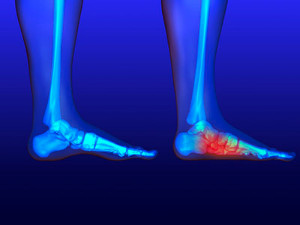 A condition referred to as flat feet is a result of arches that have dropped. It can cause a feeling of tiredness in the Feet, in addition to moderate aches and pains. If the entire foot touches the ground while standing, chances are favorable that you may have this ailment. The purpose of the arch is to raise the middle of the foot, which is comprised of tendons, bones, ligaments, and muscles. When the arch develops correctly, the foot is able to balance, walk, and run, in addition to the ability to absorb any physical shock the feet may endure. Most babies are born with flat feet that generally disappear as the child progresses in age. There are several reasons why this condition may occur in adults, including injuries that affect the joints and tissues, damage the foot may have incurred, or a predisposed inherited gene. If pain is experienced or you have noticed the arches have collapsed, contact your podiatrist.
A condition referred to as flat feet is a result of arches that have dropped. It can cause a feeling of tiredness in the Feet, in addition to moderate aches and pains. If the entire foot touches the ground while standing, chances are favorable that you may have this ailment. The purpose of the arch is to raise the middle of the foot, which is comprised of tendons, bones, ligaments, and muscles. When the arch develops correctly, the foot is able to balance, walk, and run, in addition to the ability to absorb any physical shock the feet may endure. Most babies are born with flat feet that generally disappear as the child progresses in age. There are several reasons why this condition may occur in adults, including injuries that affect the joints and tissues, damage the foot may have incurred, or a predisposed inherited gene. If pain is experienced or you have noticed the arches have collapsed, contact your podiatrist.
Flatfoot is a condition many people suffer from. If you have flat feet, contact Brent Harwood, DPM from Southeast Podiatry. Our doctor will treat your foot care needs.
What Are Flat Feet?
Flatfoot is a condition in which the arch of the foot is depressed and the sole of the foot is almost completely in contact with the ground. About 20-30% of the population generally has flat feet because their arches never formed during growth.
Conditions & Problems:
Having flat feet makes it difficult to run or walk because of the stress placed on the .
Alignment – The general alignment of your legs can be disrupted, because the move inward which can cause major discomfort.
Knees – If you have complications with your knees, flat feet can be a contributor to arthritis in that area.
Symptoms
Treatment
If you are experiencing pain and stress on the foot you may weaken the posterior tibial tendon, which runs around the inside of the .
If you have any questions please feel free to contact one of our offices located in Fairhope, Brewton, and Atmore, AL . We offer the newest diagnostic and treatment technologies for all your foot care needs.
Read more about Flat Feet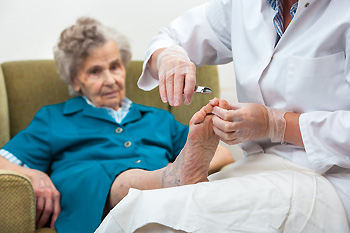 It’s important to practice good foot care, and this is especially true of the elderly population. This may include checking the feet daily, and if this proves to be a difficult task, a family member may be able to help. Recent research has shown that it's beneficial to elevate the feet as much as possible, and this will enable the blood to circulate freely. The feet typically get larger as the aging process occurs, and a key element in having healthy feet is to choose shoes that fit properly and comfortably. Some of the foot problems that elderly people need to be aware of developing are fungal and bacterial conditions, and this can include athlete’s foot and warts. Prevention of these conditions and others such as corns, calluses, and ingrown toenails is imperative in maintaining good foot health. Please consider scheduling a consultation with a podiatrist for additional information on how to take care of elderly feet.
It’s important to practice good foot care, and this is especially true of the elderly population. This may include checking the feet daily, and if this proves to be a difficult task, a family member may be able to help. Recent research has shown that it's beneficial to elevate the feet as much as possible, and this will enable the blood to circulate freely. The feet typically get larger as the aging process occurs, and a key element in having healthy feet is to choose shoes that fit properly and comfortably. Some of the foot problems that elderly people need to be aware of developing are fungal and bacterial conditions, and this can include athlete’s foot and warts. Prevention of these conditions and others such as corns, calluses, and ingrown toenails is imperative in maintaining good foot health. Please consider scheduling a consultation with a podiatrist for additional information on how to take care of elderly feet.
Proper foot care is something many older adults forget to consider. If you have any concerns about your Feet, contact Brent Harwood, DPM from Southeast Podiatry. Our doctor can provide the care you need to keep you pain-free and on your feet.
The Elderly and Their Feet
As we age we start to notice many changes in our body, but the elder population may not notice them right away. Medical conditions may prevent the elderly to take notice of their foot health right away. Poor vision is a lead contributor to not taking action for the elderly.
Common Conditions
Susceptible Infections
Diabetes and poor circulation can cause general loss of sensitivity over the years, turning a simple cut into a serious issue.
If you have any questions please feel free to contact one of our offices located in Fairhope, Brewton, and Atmore, AL . We offer the newest diagnostic and treatment technologies for all your foot care needs.
Read more about Elderly and their Feet Runners may be prone to experiencing injuries frequently if they neglect to perform proper training techniques. The feet endure an enormous amount of stress because of the pounding that occurs while running. If you choose to run as a part of your daily or weekly workout, it’s advised to slowly increase the distance and speed of your run. A runner’s worst nightmare can come from an injury that forces the running to cease. An injury to the Achilles tendon is common if proper stretching exercises are not performed prior to running. To prevent injury from occurring, stretching this tendon is crucial and needs to be implemented daily. This may help you avoid any irritation that can causes tendinitis. Additionally, if pain and tenderness in the heel is present, you may have a condition referred to as plantar fasciitis. This is caused by small tears in the tendons that connect the heel to the toes. It is suggested to schedule a consultation with a podiatrist to discuss treatment options if your feet are affected by a running injury.
Runners may be prone to experiencing injuries frequently if they neglect to perform proper training techniques. The feet endure an enormous amount of stress because of the pounding that occurs while running. If you choose to run as a part of your daily or weekly workout, it’s advised to slowly increase the distance and speed of your run. A runner’s worst nightmare can come from an injury that forces the running to cease. An injury to the Achilles tendon is common if proper stretching exercises are not performed prior to running. To prevent injury from occurring, stretching this tendon is crucial and needs to be implemented daily. This may help you avoid any irritation that can causes tendinitis. Additionally, if pain and tenderness in the heel is present, you may have a condition referred to as plantar fasciitis. This is caused by small tears in the tendons that connect the heel to the toes. It is suggested to schedule a consultation with a podiatrist to discuss treatment options if your feet are affected by a running injury.
Exercising your feet regularly with the proper foot wear is a great way to prevent injuries. If you have any concerns about your feet, contact Brent Harwood, DPM of Southeast Podiatry. Our doctor will treat your foot care needs.
How to Prevent Running Injuries
Many common running injuries are caused by overuse and overtraining. When the back of the kneecap starts wearing out and starts causing pain in your knee, this is commonly referred to as runner’s knee. Runner’s knee is a decrease in strength in your quadriceps and can occur if you’re not wearing properly fitted or supporting shoes. To prevent runner’s knee, focusing on hip strengthening is a good idea, as well as strengthening your quads to keep the kneecaps aligned.
What Are Some Causes of Running Injuries?
- One cause of a common running injury is called iliotibial band syndrome.
- Plantar fasciitis is also another common injury.
- Stress fractures can occur from overtraining, lack of calcium, or even your running style.
Best Ways to Prevent Running Injuries
- Wear footwear that fits properly and suits your running needs.
- Running shoes are the only protective gear that runners have to safeguard them from injury.
- Make a training schedule. Adding strengthening exercises as well as regular stretching can help keep you strong and limber and can lessen the possibility of injuries.
- Stretching keeps muscles limber; this will help you gain better flexibility.
If you have any questions please feel free to contact one of our offices located in Fairhope, Brewton, and Atmore, AL . We offer the newest diagnostic and treatment technologies for all your foot care needs.
Read more about How to Prevent Running Injuries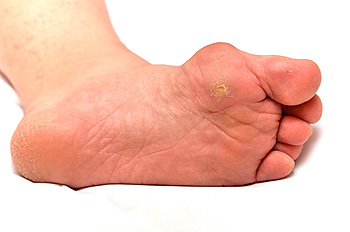 If you have a growth on the bottom of the big toe that appears to be of a bony consistency, you may have what is referred to as a bunion. Symptoms of this condition may consist of pain and swelling around the big toe, in addition to the area feeling sore, and appearing red. They are often caused by a predisposed inherited gene. Additionally, choosing to wear shoes that fit poorly may be another possible cause of bunions. This condition may be more prevalent in women than men because of the type of shoes that are worn. This may occur if high heels are worn frequently, causing the toes to be cramped into a small area, which eventually may change the structure of the foot. Treatment options may include using bunion pads which will cushion the affected area, and may possibly eliminate any discomfort. A consultation with a podiatrist may be considered to discuss proper treatment techniques which may include surgery.
If you have a growth on the bottom of the big toe that appears to be of a bony consistency, you may have what is referred to as a bunion. Symptoms of this condition may consist of pain and swelling around the big toe, in addition to the area feeling sore, and appearing red. They are often caused by a predisposed inherited gene. Additionally, choosing to wear shoes that fit poorly may be another possible cause of bunions. This condition may be more prevalent in women than men because of the type of shoes that are worn. This may occur if high heels are worn frequently, causing the toes to be cramped into a small area, which eventually may change the structure of the foot. Treatment options may include using bunion pads which will cushion the affected area, and may possibly eliminate any discomfort. A consultation with a podiatrist may be considered to discuss proper treatment techniques which may include surgery.
If you are suffering from bunions, contact Brent Harwood, DPM of Southeast Podiatry. Our doctor can provide the care you need to keep you pain-free and on your feet.
What Is a Bunion?
A bunion is formed of swollen tissue or an enlargement of boney growth, usually located at the base joint of the toe that connects to the foot. The swelling occurs due to the bones in the big toe shifting inward, which impacts the other toes of the foot. This causes the area around the base of the big toe to become inflamed and painful.
Why Do Bunions Form?
Genetics – Susceptibility to bunions are often hereditary
Stress on the feet – Poorly fitted and uncomfortable footwear that places stress on feet, such as heels, can worsen existing bunions
How Are Bunions Diagnosed?
Doctors often perform two tests – blood tests and x-rays – when trying to diagnose bunions, especially in the early stages of development. Blood tests help determine if the foot pain is being caused by something else, such as arthritis, while x-rays provide a clear picture of your bone structure to your doctor.
How Are Bunions Treated?
If you have any questions, please feel free to contact one of our offices located in Fairhope, Brewton, and Atmore, AL . We offer the newest diagnostic and treatment technologies for all your foot care needs.
Read more about Bunions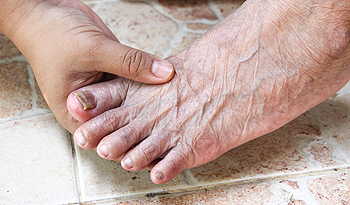 White or yellow toenails is often indicative of a toenail fungus. Severe fungal infections can cause thickening of the nail, and even cause it to crumble and fall off the toe. If the feet are prone to excessive sweating, the chances may be increased for developing a toenail fungus. Additionally, this condition is contagious, and is often spread by walking barefoot in public places such as on shower floors and around community pools. Treatment remedies that may aid in helping the foot to feel better may include using a foot powder designed to eliminate moisture. Choosing to change socks often and keeping the toenails dry and trimmed will help the toes to feel better. A consultation with a podiatrist is recommended for treatment options.
White or yellow toenails is often indicative of a toenail fungus. Severe fungal infections can cause thickening of the nail, and even cause it to crumble and fall off the toe. If the feet are prone to excessive sweating, the chances may be increased for developing a toenail fungus. Additionally, this condition is contagious, and is often spread by walking barefoot in public places such as on shower floors and around community pools. Treatment remedies that may aid in helping the foot to feel better may include using a foot powder designed to eliminate moisture. Choosing to change socks often and keeping the toenails dry and trimmed will help the toes to feel better. A consultation with a podiatrist is recommended for treatment options.
For more information about treatment, contact Brent Harwood, DPM of Southeast Podiatry. Our doctor can provide the care you need to keep you pain-free and on your feet.
Toenail Fungus Treatment
Toenail fungus is a condition that affects many people and can be especially hard to get rid of. Fortunately, there are several methods to go about treating and avoiding it.
Antifungals & Deterrence
Oral antifungal medicine has been shown to be effective in many cases. It is important to consult with a podiatrist to determine the proper regiment for you, or potentially explore other options.
Applying foot powder on the feet and shoes helps keep the feet free of moisture and sweat.
Sandals or open toed shoes – Wearing these will allow air movement and help keep feet dry. They also expose your feet to light, which fungus cannot tolerate. Socks with moisture wicking material also help as well.
If you have any questions please feel free to contact one of our offices located in Fairhope, Brewton, and Atmore, AL . We offer the newest diagnostic tools and technology to treat your foot care needs.
Read more about Toenail Fungus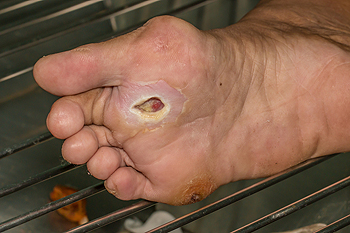 There is a high risk of foot amputation for people with diabetes. It’s important to keep an eye on your foot’s health in order to avoid serious complications. To begin with, it’s important to look out for foot ulcers. Foot ulcers are the most common foot injury associated with diabetes. If left untreated, a foot ulcer can eventually lead to amputation of the foot or even the lower leg. If you think you have a foot ulcer, it's advised to get it checked out by a podiatrist. Other ways to avoid serious complications with diabetic feet are as follows: Take care of your feet by avoiding minor foot injuries, examine your feet regularly, clean your feet often as well as keep them dry, and spot any problems early. Lastly, and most importantly, be sure to see your podiatrist if you have any worries or notice any sudden changes in sensation.
There is a high risk of foot amputation for people with diabetes. It’s important to keep an eye on your foot’s health in order to avoid serious complications. To begin with, it’s important to look out for foot ulcers. Foot ulcers are the most common foot injury associated with diabetes. If left untreated, a foot ulcer can eventually lead to amputation of the foot or even the lower leg. If you think you have a foot ulcer, it's advised to get it checked out by a podiatrist. Other ways to avoid serious complications with diabetic feet are as follows: Take care of your feet by avoiding minor foot injuries, examine your feet regularly, clean your feet often as well as keep them dry, and spot any problems early. Lastly, and most importantly, be sure to see your podiatrist if you have any worries or notice any sudden changes in sensation.
Diabetic foot care is important in preventing foot ailments such as ulcers. If you are suffering from diabetes or have any other concerns about your feet, contact Brent Harwood, DPM from Southeast Podiatry. Our doctor can provide the care you need to keep you pain-free and on your feet.
Diabetic Foot Care
Diabetes affects millions of people every year. The condition can damage blood vessels in many parts of the body, especially the feet. Because of this, taking care of your feet is essential if you have diabetes, and having a podiatrist help monitor your foot health is highly recommended.
The Importance of Caring for Your Feet
Patients with diabetes should have their doctor monitor their blood levels, as blood sugar levels play such a huge role in diabetic care. Monitoring these levels on a regular basis is highly advised.
It is always best to inform your healthcare professional of any concerns you may have regarding your feet, especially for diabetic patients. Early treatment and routine foot examinations are keys to maintaining proper health, especially because severe complications can arise if proper treatment is not applied.
If you have any questions please feel free to contact one of our offices located in Fairhope, Brewton, and Atmore, AL . We offer the newest diagnostic and treatment technologies for all your foot and ankle needs.